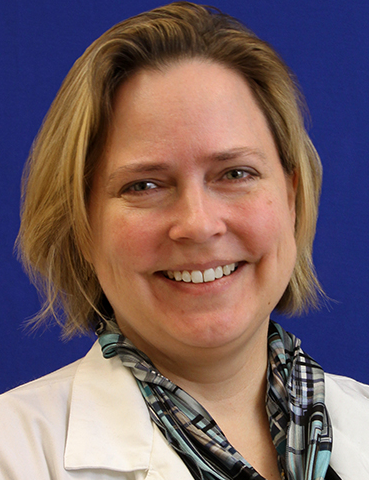08:00 | Conference Registration, Materials Pick-Up, Morning Coffee and Breakfast Pastries |
|
Session Title: Conference Plenary Session -- Emerging Themes in Circulating Biomarkers and Liquid Biopsies |
| |
|
Plenary Session Chairperson: Lucia R. Languino, Ph.D., Professor of Cancer Biology, Thomas Jefferson University |
| |
09:00 |  | Keynote Presentation Mt-SEA Pipeline: High Throughput Flow Cytometric Analysis of Exosomes in Clinical Biofluids
Jennifer Jones, NIH Stadtman Investigator, Head of Transnational Nanobiology, Laboratory of Pathology, Center for Cancer Research, National Cancer Institute, United States of America
Because Extracellular Vesicles (EVs) carry surface receptors that are characteristic of their cells of origin, EVs have tremendous potential as non-invasive biomarkers for diagnosis, risk-stratification, treatment selection, and treatment monitoring. We developed a first-in-class pipeline to characterize EV heterogeneity and provide high-sensitivity quantification of informative EVs in biofluids before, during, and after treatment. By combining multiplex assays with high-resolution, single EV flow cytometric methods together into a Mutiplex-to-Single EV Analysis (Mt-SEA) pipeline, we are able to characterize a broad range of relevant EV subsets, while also accurately measuring the concentration of specific EV populations. Detection of tumor-associated EVs and detection of EV repertoire changes during treatment paves the way to future evaluation of EVs as as biomarkers for use in personalized, adaptive therapies. |
|
09:30 |  | Keynote Presentation Disease-Specific Vascular Markers for Cancer, Atherosclerosis and Brain Diseases
Erkki Ruoslahti, Distinguished Professor and Former President, Sanford Burnham Prebys Medical Discovery Institute, United States of America
We study peptides that home to specific targets in the body. We discover the homing peptides by screening phage libraries for peptides that direct homing of phages to the target tissue in vivo. The homing peptides, which usually bind to receptors in the vessels of the target tissue, can be used to selectively deliver diagnostic probes and drugs to the target. The latest development is the discovery of tumor-penetrating peptides. These peptides activate an endocytic bulk transport pathway we have dubbed the CendR pathway, which can enhance the exit from blood and tissue penetration co-administered compounds even without chemical coupling to the peptide (Ruoslahti, Adv Mater. (2012) 24 3747). We have also identified peptides specific for atherosclerotic plaques, accumulate at the site of a brain injury or recognize the blood vessels in Alzheimer’s disease brain. Our homing frequency have an intrinsic biological active I the disease they target. Examples of the peptide discovery process from initial screening to clinical trials will be given. |
|
10:00 | Coffee Break and Networking in the Exhibit Hall |
10:45 |  | Keynote Presentation Precision Medicine Using Liquid Biopsies: A New Paradigm for Managing Cancer Diseases
Steve Soper, Foundation Distinguished Professor, Director, Center of BioModular Multi-Scale System for Precision Medicine, The University of Kansas, United States of America
Precision medicine seeks to match patients to appropriate therapies that optimize clinical outcome from molecular signatures of their disease. These molecular signatures can be secured from circulating markers found in blood (i.e., liquid biopsies). The marker types include circulating tumor cells (CTCs), cell-free DNA (cfDNA), and nanoscale vesicles (exosomes). Unfortunately, many disease-associated blood markers are a vast minority in a mixed population making them difficult to analyze due to deficiencies in current technologies used for their isolation. To address this deficiency, we are generating innovative microfluidic tools for selecting circulating markers from whole blood and determining the presence/absence of disease-specific molecular signatures secured from the liquid biopsy markers to guide therapy for a patient. The microfluidics can process whole blood (=1 mL) and search for CTCs, cfDNA, or exosomes and make them available for downstream molecular processing. The microfluidics are made in plastics via injection molding, making them particularly attractive for clinical implementation, which demands low-cost disposables. In this keynote address, I will discuss our microfluidic platforms for CTC, cfDNA, and exosome isolation. The exosome chip consists of 1.4 million pillars that contain surface-immobilized antibodies directed against antigens from cancer cells that are epithelial based (EpCAM) and those with a mesenchymal phenotype (fibrobast activation protein alpha, FAPa). I will then talk extensively about our exosome isolation chip, and its use in several clinical examples and securing molecular information from the affinity-selected exosomes. |
|
11:15 |  | Conference Chair Exosomes: Novel Opportunities for the Diagnosis and Therapy of Cancer
Lucia Languino, Professor of Cancer Biology, Thomas Jefferson University, United States of America
|
|
11:45 |  | Keynote Presentation Tumor-derived Exosomes Contribute to a Pro-inflammatory Tumor Microenvironment through the Stimulation of Chemokines and Cytokines in Mesenchymal Stromal Cells and Macrophages
Yves A. DeClerck, Professor of Pediatrics and Biochemistry & Molecular Medicine, Children’s Hospital Los Angeles, University of Southern California, United States of America
Exosomes are members of a large family of extracellular vesicles involved in cell-cell communication that play important regulatory functions in physiological and pathological conditions. Using neuroblastoma (NB), the second most common solid tumor in children and a cancer that is highly metastatic to the bone marrow and the liver as a model, we show that NB-derived exosomes contribute to the stimulation of several protumorigenic cytokines and chemokines (IL-6, IL-8, MCP-1, VEGF) by mesenchymal stromal cells (MSC) and macrophages via ERK1/2 activation. In vivo NB-derived exosomes are also preferentially captured by macrophages at the site of metastasis (bone marrow and liver). Altogether these cytokines promotes the proliferation of tumor cells, their resistance to chemotherapy and immune escape via STAT3 and ERK1/2 activation. |
|
12:15 | Networking Lunch in the Exhibit Hall and Poster Viewing |
|
Session Title: Intercellular Communication Mediated by Exosomes/EVs - An Emerging Class of Circulating Biomarkers |
| |
13:30 |  | Keynote Presentation Chemistry-Free Microfluidic Technologies to Sort Cells for Health and Disease
Utkan Demirci, Professor, Stanford University School of Medicine, United States of America
Micro- and nano-scale technologies can have a significant impact on medicine and biology in the areas of cell manipulation, diagnostics and monitoring. At the convergence of new technologies and biology, our research is centered on enabling solutions to real world problems at the clinical level. Emerging nano-scale and microfluidic technologies integrated with biology offer innovative possibilities for creating intelligent and mobile medical lab-chip devices that could transform diagnostics and monitoring, tissue engineering and regenerative medicine. In this talk, we will first present an overview of our laboratory's work in the areas focused on applications in magnetic levitation methods for assembling cells and chemistry free sorting of rare cells from whole blood. Cells consist of micro- and nano-scale components and materials that contribute to their fundamental magnetic and density signatures. Previous studies have claimed that magnetic levitation can only be used to measure density signatures of non-living materials. Here, we demonstrate that both eukaryotic and prokaryotic cells can be levitated and that each cell has a unique levitation profile. Furthermore, our levitation platform uniquely enables ultrasensitive density measurements, imaging, and profiling of cells in real-time at single-cell resolution. This method has broad applications, such as the label-free identification and sorting of CTCs and CTM with broad applications in drug screening in personalized medicine. Second, we will present some of our efforts on developing new tools to isolate extracellular vesicles from blood, urine and cell cultures. I will also share some of the clinical implications of these technologies indicating the broader potential that chemistry-free and label-free microfluidic-based technologies have in medicine. |
|
14:00 | Cancer–Host Crosstalk Through Exosomal miRNA
Shizhen Emily Wang, Associate Professor, Department of Pathology, University of California, San Diego, United States of America
Extracellular microRNAs (miRNAs) that can be detected in the circulation are novel mediators of intercellular communication and are considered emerging biomarkers for human diseases. Using cell-secreted extracellular vesicles (e.g., exosomes) as vehicles, miRNAs secreted by cancer cells can travel to and enter various types of niche cells in primary and pre-metastatic tumor microenvironments. Upon entering niche cells, miRNAs regulate gene expression to prepare the niche for cancer progression. Our lab focuses on defining the roles of breast cancer secreted miRNAs in adapting local and distal niche cells and tissues in cancer progression and metastasis. Through de novo sequencing and PCR of circulating small RNAs in the sera of breast cancer patients we identified circulating miRNAs as biomarkers for cancer progression to metastatic disease. Subsequent mechanistic studies revealed important functions of breast cancer secreted miRNAs in various aspects of cellular behaviors. Our findings reveal (1) vascular leakiness and enhanced metastasis caused by cancer-secreted miR-105, which downregulates endothelial tight junctions; (2) miR-105-induced metabolic plasticity in cancer-associated fibroblasts to convert cancer-produced metabolic wastes (e.g., lactate and ammonia) into energy-rich metabolites to re-enter cancer bioenergetics; (3) suppressed glucose utilization by lung fibroblasts and astrocytes in favor of glucose uptake by metastasized cancer cells mediated by cancer-secreted miR-122. |
14:30 |  A Straightforward, Automated and Standardizable Approach to Purifying and Characterizing the Biophysical Properties of EVs; Size, Concentration and Surface Charge A Straightforward, Automated and Standardizable Approach to Purifying and Characterizing the Biophysical Properties of EVs; Size, Concentration and Surface Charge
Shayne Harrel, Chief Scientist-Americas, Izon Science US LTD
The ever increasing discovery of the role of extracellular vesicles (EVs) in a wide range of biological roles and functions has lead them to be realized as a prime candidate for the next generation platform of medical diagnostics and therapeutics. As such, an accurate, repeatable and standardizable approach to measuring the biophysical properties of these particles such as concentration, particle size and surface charge and correlating these biophysical properties to biological role and function is desperately required. This presentation will focus on recent developments at Izon Science which have created an integrated methodology for the straightforward, automated purification of EVs and subsequent characterization of their biophysical properties.
|
15:00 | Modulation of Extracellular Vesicle Release and Content in SCC Cells
My Mahoney, Professor and Vice Chair, Thomas Jefferson University, United States of America
Emerging as critical in the pathobiology of cancer are nanosized extracellular membrane vesicles (EVs) secreted by tumor cells into the blood and other bodily fluids carrying molecular constituents to modulate local and distant tumor microenvironment. EVs can be taken up by recipient cells and can modulate diverse biological processes including cell polarity and tissue morphogenesis and represent novel and valuable circulating biomarkers for tumor prognosis and diagnosis. Thus, defining factors that affect the release or modify the content of EVs is critical to our understanding of not only normal tissue development but also malignant transformation and progression. We have shown that the cadherin desmoglein 2 (Dsg2), an important regulator of growth and survival signaling pathways, drives tumorigenesis in experimental models, and clinical samples confirm that Dsg2 is indeed overexpressed in those cancers. We observed that Dsg2 is enriched in EVs derived from SCC cells and patient sera. Dsg2 modulates EV release and mitogenic content including EGFR and c-Src. Dsg2-labeled EVs are taken up by dermal fibroblasts, activating Erk1/2 and Akt signaling and promoting cell proliferation. Our work thus far defines a mechanism by which cancer cells can modulate the tumor microenvironment, a step critical for tumor progression. |
15:30 | Coffee Break and Networking in the Exhibit Hall |
16:00 |  Nano-Flow Cytometry: Next-Generation Platform for Comprehensive EV Analysis Nano-Flow Cytometry: Next-Generation Platform for Comprehensive EV Analysis
Dimitri Aubert, Managing Director, NanoFCM Co., Ltd
Though of great importance, sizing and molecular profiling of individual extracellular vesicles (EVs) are technically challenging due to their nanoscale particle size, minute quantity of analytes, and overall heterogeneity. NanoFCM has developed Nano-Flow Cytometry (nFCM), a technology that allows light scattering and fluorescence detection of single EVs down to 40 nm. nFCM-based approach for quantitative multiparameter analysis of EVs, which is highly desirable to decipher their biological functions and promote the development of EV-based liquid biopsy and therapeutics.
|
16:30 | A Novel Extracellular Vesicle Isolation Method Used to Discover Urine Liver Disease Candidate Biomarkers
Shannon Pendergrast, Chief Scientific Officer, Ymir Genomics, United States of America
Hepatocellular carcinoma (HCC) is the sixth most common cancer worldwide, with increasing incidence, and is the third most common cause of cancer death. The clinical management of patients suffering from HCC, despite the fact that at-risk populations are well defined, is not satisfactory. This is mainly due to the unavailability of current diagnostics to predict and monitor the disease. OHSU and Ymir Genomics LLC have teamed up to develop a high-compliance urinary diagnostic for liver diseases, including HCC. We have developed a new method for the rapid and effective isolation of urine extracellular vesicles (EVs) and integrated that into Mass Spectrometry and miRNA array workflows. We have applied the workflow to 3 groups of 20 urine samples each from 1) healthy controls, 2) patients with cirrhosis, and 3) and cirrhotic patients with untreated HCC. Mass Spectrometry data shows that this protocol is capable of identifying over 2500 proteins from only 2 mls of urine; far less sample than some previously reported urine EV proteomics studies. Our protocol also yields sensitive miRNA detection from the Firefly miRNA array. Preliminary data establishes proof-of-concept by identifying multiple liver-selective and known liver disease biomarkers in urine EV preps. Several candidate protein and miRNA biomarkers that are potentially capable of distinguishing disease from healthy groups have also been identified. The methods developed in this study are suitable for a larger longitudinal study, as they are already compatible with standard clinical chemistry laboratory assay requirements. Hopefully, candidates biomarkers identified in this study will provide clinicians with powerful weapons in the fight against HCC. |
17:00 |  EV Biomarker Detection using Particle Metrix ZetaView® Instruments and Fluorescent Nanoparticle Tracking Analysis (F-NTA) EV Biomarker Detection using Particle Metrix ZetaView® Instruments and Fluorescent Nanoparticle Tracking Analysis (F-NTA)
Sven Rudolf Kreutel, Chief Executive Officer, Particle Metrix GmbH and CEO, Particle Metrix Inc., USA
|
17:30 | Low Coverage, Genome-Wide Sequencing of Cell-Free DNA Enables the Monitoring of Response to Immunotherapy in Cancer Patients
Taylor Jensen, Director, Research and Development, Sequenom (a LabCorp Company), United States of America
Inhibitors of the PD-1/PD-L1/CTLA4 immune checkpoint pathway have
revolutionized cancer treatment with a subset of patients showing
durable responses; however, challenges remain in the development of
biomarkers to predict or monitor response to these therapies. The use
of cell-free DNA (cfDNA) isolated from plasma, or liquid biopsy,
provides a promising method for monitoring response. In contrast to
methods that use ultra-deep (>30,000X) targeted sequencing, we will
describe a recently completed a proof-of-concept study using
low-coverage (~0.3X), genome-wide sequencing of cfDNA to detect
tumor-specific copy number alterations. As part of this study, we have
developed a novel metric, the Genome Instability Number (GIN), to
monitor response to these drugs throughout treatment. In a series of
case studies, we will describe how the GIN can be used to discriminate
clinical response from progression, differentiate progression from
pseudoprogression and identify hyperprogressive disease. In addition,
we have utilized this metric to provide evidence for a delayed
pharmacokinetic response for checkpoint inhibitors relative to targeted
therapies. |
18:00 | Networking Reception with Beer and Wine in the Exhibit Hall |
19:00 | Close of Day 1 of the Conference. |
19:30 | Start of Exosomes/Extracellular Vesicles (EV) Training Course [Separate Registration Required to Attend this Training Course] |











